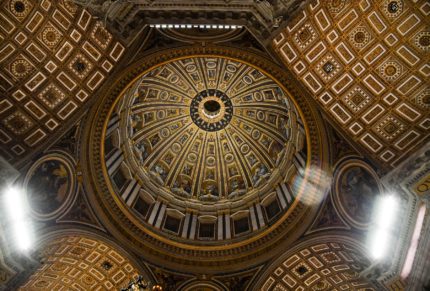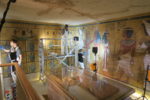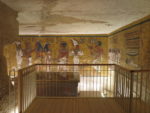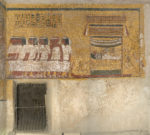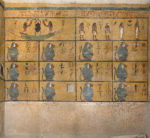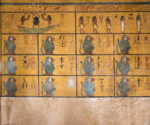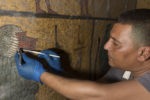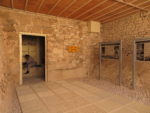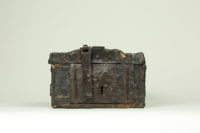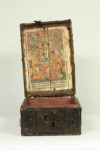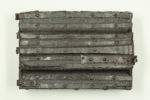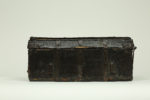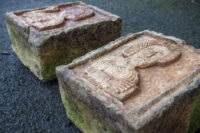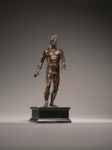 A bronze statuette of the god Mars by Mannerist master Giambologna is returning to Dresden almost a century after it was sold away. Its homecoming is so heralded because the sculptor himself sent it to Dresden 432 years ago.
A bronze statuette of the god Mars by Mannerist master Giambologna is returning to Dresden almost a century after it was sold away. Its homecoming is so heralded because the sculptor himself sent it to Dresden 432 years ago.
Born Jean Boulogne in Douai, Flanders, in 1529, Giambologna traveled to Rome in 1550 where he was influenced by Classical art and Renaissance masters like Michelangelo and Raphael. He moved to Florence in 1553 where his refined approach to the contortionist Mannerist style earned him a position as the top sculptor at the court of the Medici Grand Dukes of Tuscany by 1560.
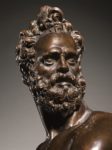 The Medici were so protective of their greatest sculptor that they never allowed him to leave Florence out of fear that one of the Habsburg imperial courts would lure him away. His works were so famous they were widely copied. Very few of his sculptures have undisputed documentation of having been produced by his hand during his lifetime. The Dresden Mars is one of them.
The Medici were so protective of their greatest sculptor that they never allowed him to leave Florence out of fear that one of the Habsburg imperial courts would lure him away. His works were so famous they were widely copied. Very few of his sculptures have undisputed documentation of having been produced by his hand during his lifetime. The Dresden Mars is one of them.
It is the earliest cast of the artist’s Mars, made by Giambologna as a personal gift for 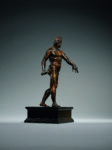 Christian I, Elector of Saxony (1560-1591). It is the most significant and powerful of his male nudes, the strength of the mythological deity conveyed by his dynamic stride, detailed musculature and intense glare. The usual attributes of Mars — helmet, shield, spear — are absent, with only the hilt of a sword clutched in his right fist standing in for them.
Christian I, Elector of Saxony (1560-1591). It is the most significant and powerful of his male nudes, the strength of the mythological deity conveyed by his dynamic stride, detailed musculature and intense glare. The usual attributes of Mars — helmet, shield, spear — are absent, with only the hilt of a sword clutched in his right fist standing in for them.
It was made before 1587, the year it arrived in Saxony. Inventory records of the Dresden Kunstkammer note its arrival: “Brass cast portrait of Mars, sent by Giovanni Bologna to His Grace the Elector.” It’s the only Giambologna piece known to have been created for a prince and the sculptor made certain that it was of royal quality.  Christian I was keenly aware that it was an exceptional work. In return, the Elector commissioned a hugely expensive necklace from goldsmith Urban Schneeweiss to thank Giambologna for his generous gift. It is believed he was wearing the prized jewel when he sat for a 1591 chalk portrait by Hendrik Goltzius now in the collection of the Teylers Museum in Haarlem.
Christian I was keenly aware that it was an exceptional work. In return, the Elector commissioned a hugely expensive necklace from goldsmith Urban Schneeweiss to thank Giambologna for his generous gift. It is believed he was wearing the prized jewel when he sat for a 1591 chalk portrait by Hendrik Goltzius now in the collection of the Teylers Museum in Haarlem.
After three centuries at the Kunstkammer, the masterpiece went into private ownership in 1924, a casualty of the complicated aftermath of World War I. In the wake of Germany’s defeat in 1918 and the abdication of the Kaiser, the last King of Saxony, Frederick Augustus III abdicated as well. The kingdom became the Free State of Saxony, a semi-autonomous state in the Weimar Republic. The new state confiscated the former king’s assets but he refuse to walk away from them as he had the throne. Instead he hired a lawyer and in 1919 sued the Free State of Saxony for illegally requisitioning his family patrimony. He claimed a passel of real estate, millions in cash and securities and 17.5 million marks’ worth of art.
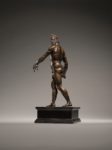 A commission was formed to negotiate a settlement. It took many years of stops and starts, amendments and provisos before the deal was sealed. In 1924, Frederick Augustus got castles, lots of cash and a buttload of art from the collections of multiple museums, including the Kupferstichkabinett Dresden, now the Staatliche Kunstsammlungen Dresden (SKD).
A commission was formed to negotiate a settlement. It took many years of stops and starts, amendments and provisos before the deal was sealed. In 1924, Frederick Augustus got castles, lots of cash and a buttload of art from the collections of multiple museums, including the Kupferstichkabinett Dresden, now the Staatliche Kunstsammlungen Dresden (SKD).
He was more into the castles and cash than the art. The Dresden Mars was consigned to an art gallery in Berlin which sold it to Theodor Plieninger, General Director of Chemische Werke Griesheim-Elektron, in 1927. Griesheim-Elektron gave it to a member of the board of directors Constantin Jacobi as a retirement present in 1943. Sure beats the usual gold watch. It remained in his family until 1988 when his son and heir Walter Jacobi gave it Bayer AG.
In 2018, Bayer decided to sell Mars at a Sotheby’s auction. The company’s art collection is almost entirely modern, with the Giambologna as its only Renaissance piece and the infusion of millions of dollars from the sale would give them the chance to grow the collection’s contemporary art. Sotheby’s pre-sale estimate was £3-5 million ($4-6.6 million) and it was thrilled to be handling an original Giambologna because they basically never come on the market.
A week before the auction, the SKD, armed with contributions from Free State of Saxony, the Federal Government Commissioner for Culture and Media, the Ernst von Siemens Kunststiftung, the German Federal Cultural Foundation and the Friends of the SKD, approached Bayer AG offering a private sale. On July 3rd, the day before the scheduled auction, the deal was made and the lot withdrawn.
The Dresden Mars will go on permanent display in the SKD’s Gemäldegalerie Alte Meister when it reopens after refurbishment in December of this year. As of this week, it is going on a Welcome Home Tour through Saxony, beginning at the Stadt-und Bergbaumuseum Freiberg then moving to the Schloss Hartenfels in Torgau and making its last stop on the tour at the Schlossbergmuseum Chemnit.
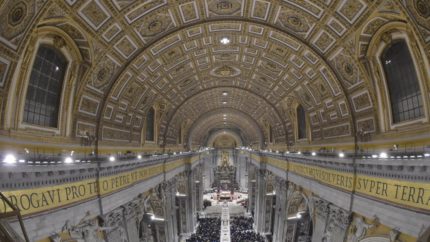
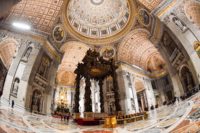 There are 780 new fixtures installed in the basilica at heights ranging from 40 and 360 feet, all artfully camouflaged. They add up to around 100,000 LEDs generating more than 10 times the light with 80% fewer fixtures. The energy savings are enormous, up to 90% over the previous system. The lighting can be controlled in minute detail by a digital system which will allow different elements to be emphasized on different occasions. It will allow video capture in 4K and 8K for ultra high definition television broadcasts and recordings.
There are 780 new fixtures installed in the basilica at heights ranging from 40 and 360 feet, all artfully camouflaged. They add up to around 100,000 LEDs generating more than 10 times the light with 80% fewer fixtures. The energy savings are enormous, up to 90% over the previous system. The lighting can be controlled in minute detail by a digital system which will allow different elements to be emphasized on different occasions. It will allow video capture in 4K and 8K for ultra high definition television broadcasts and recordings.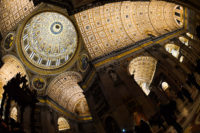 More than 27,000 people visit St. Peter’s every day. These improvements will enhance the experience for the thousands of pilgrims who flock to the basilica to celebrate religious events, making it much easier to get a decent view of the Pope and other concelebrants. An even greater advantage will go to the lovers of art and architecture who also flock to St. Peter’s and wait in its insane lines without the consolation of religious fervor. The architectural and decorative features of one of the masterpieces of Renaissance construction are now visible in a whole new depth. The areas that were lit by the old system, like the main dome, originally designed by Bramante and redesigned and strengthened by Michelangelo, are now so clearly lit that details can be seen which were previously invisible. Places that could not be lit under the old regime are now dazzling, including the octagons and mini-cupolas of the side aisles. You simply could not see the rich mosaics that adorn these features from the ground unaided. Five hundred years ago they were lit by candles, so effectively not lit at all. Now they’re plain as day for the first time in half a millennium.
More than 27,000 people visit St. Peter’s every day. These improvements will enhance the experience for the thousands of pilgrims who flock to the basilica to celebrate religious events, making it much easier to get a decent view of the Pope and other concelebrants. An even greater advantage will go to the lovers of art and architecture who also flock to St. Peter’s and wait in its insane lines without the consolation of religious fervor. The architectural and decorative features of one of the masterpieces of Renaissance construction are now visible in a whole new depth. The areas that were lit by the old system, like the main dome, originally designed by Bramante and redesigned and strengthened by Michelangelo, are now so clearly lit that details can be seen which were previously invisible. Places that could not be lit under the old regime are now dazzling, including the octagons and mini-cupolas of the side aisles. You simply could not see the rich mosaics that adorn these features from the ground unaided. Five hundred years ago they were lit by candles, so effectively not lit at all. Now they’re plain as day for the first time in half a millennium. 